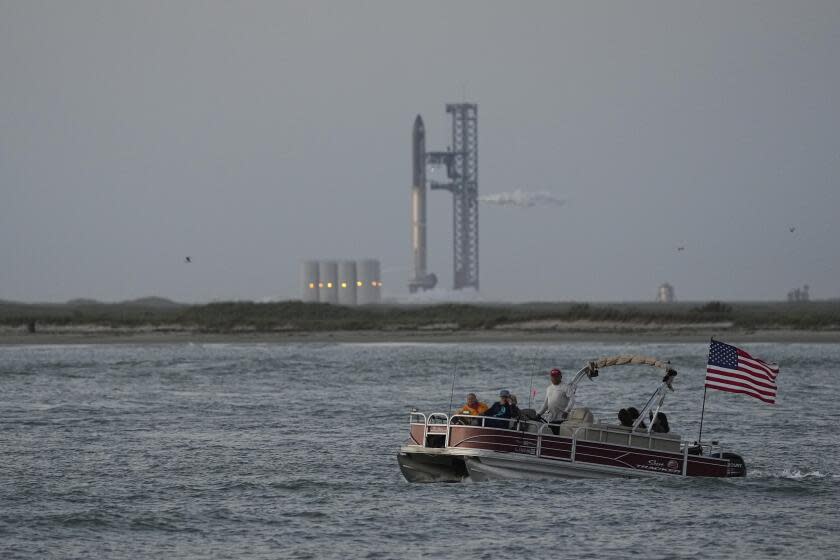In latest test flight, SpaceX's Starship splashes back to Earth as planned

SpaceX launched its Starship spacecraft into orbit Thursday in a largely successful test flight that moved the company a step closer to its ultimate goal of transporting astronauts to the moon and, someday, Mars.
Stacked on a Super Heavy rocket, the Starship capsule blasted off at 5:50 a.m. Pacific time from the company's Boca Chica, Texas, launchpad on its fourth test flight. The rocket is the most powerful ever built.
Read more: After repeated delays, Starliner finally blasts into space
The goal of Thursday's uncrewed test flight of Starship was to have the spacecraft and its rocket return to Earth in controlled descents — the capsule in the Indian Ocean and the booster rocket in the Gulf of Mexico — but there were no plans to recover the stages.
The booster rocket, after separating from the capsule, fell back toward Earth, fired its engines as planned and completed a soft landing in the water about seven minutes into the flight.
The Starship capsule, meanwhile, survived the trip back through the Earth's atmosphere intact and a little over an hour into the flight reignited its engines to maneuver to a controlled landing. The descent was a vast improvement over the third test flight when it burned up in the atmosphere on re-entry.
"Today was a great day for humanity’s future as a spacefaring civilization! Nothing unites us more than working together towards inspiring objectives," declared SpaceX founder Elon Musk on X after the flight.
Laura Forczyk, executive director of space industry consultancy Astralytical, said that after the "perfect" landing of the booster, she expects that on Starship's next flight, SpaceX will attempt to land it back on its launch pad. Attempts to land the capsule on a pad will come in the future.
Landing the capsule and rocket on land are a key strategy of Musk's Hawthorne-based company to reuse the craft and make space flights cheaper.
This was the second major launch this week and came after Boeing on Wednesday finally launched its Starliner spacecraft with a crew aboard to the International Space Station. Starliner, which has had its launches repeatedly delayed, is competing to service the station with SpaceX, which already has sent more than half a dozen crews to the orbiting lab.
Starliner had been expected to dock with the station at 9:15 a.m. Pacific on Thursday but was delayed more than an hour after thrusters on the capsule malfunctioned and had to be manually restarted. It wasn't clear if the problem was related to a helium leak in the propulsion system that has flummoxed engineers for the past few weeks.
After the leak was detected last month, NASA and Boeing delayed the launch but ultimately decided the problem wasn't significant enough to replace a leaking seal and proceeded with the mission. However, on its way to the space station, additional leaks were detected.
Thursday's flight of Starship came about three months after a March 14 test flight when Starship reached several milestones even though it broke apart on its descent.
Starship opened and closed its payload doors and transferred fuel from one tank to another, a critical function for flights into space. The test flight also was the longest yet until Thursday.
The craft's first flight in April 2023 lasted only a few minutes before the booster lost power and exploded on ascent. A second launch in November was more successful, with the rocket separating from the capsule before both were lost.
SpaceX, formally known as Space Exploration Technologies Corp., views flight failures as part of its development process, an approach that differs from traditional aerospace companies that have long preferred to perfect their technology on the ground.
The Starship space-launch system, at 397 feet, is taller and has about twice the thrust of the Saturn 5 and Apollo capsule that carried men to the moon.
It is part of NASA's Artemis program to return humans to the moon, with the goal of establishing a permanent base to facilitate missions to Mars. The program includes a second spacecraft called Orion, manufactured by NASA, Lockheed Martin and Airbus, and a Space Launch System rocket built by Boeing, Northrop Grumman and other companies.
Orion circled the moon in a successful 25-day mission that blasted off in November 2022 without a crew. A mission carrying astronauts is scheduled for no earlier than September 2025.
Starship also has a commercial component. It would allow the privately held company to launch more and larger Starlink broadband satellites than the company’s existing lineup of Falcon 9 rockets.
Last week, Japanese e-commerce billionaire Yusaku Maezawa tweeted that he had pulled out of a contract signed in 2018 to fly in Starship around the moon due to delays in the spacecraft's development. Maezawa, who wanted to fly with a half dozen artists, said he had expected the private space trip to take place in 2023.
This story originally appeared in Los Angeles Times.

 Yahoo News
Yahoo News 
